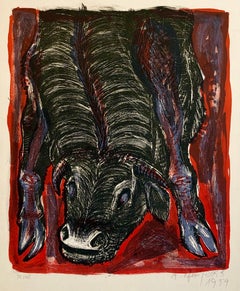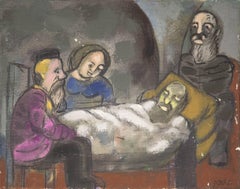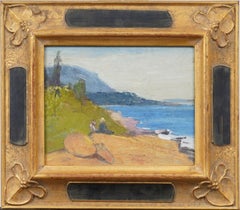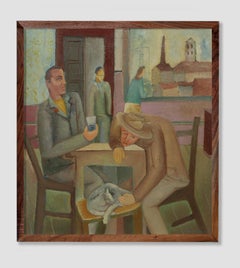Avraham Ofek Art
to
2
Overall Width
to
Overall Height
to
2
1
1
2
1
1
1
1
1
1
1
2
10,138
2,779
1,375
1,368
2
Artist: Avraham Ofek
1959 Israeli Avraham Ofek Leviathan Modernist Lithograph, Bull, Bezalel School
By Avraham Ofek
Located in Surfside, FL
Bright, vibrant purple, red and black bull or ox.
1959 Lithograph "Bull".
This was from a portfolio which included works by Yosl Bergner, Menashe Kadishman, Yosef Zaritsky, Aharon Kahana, Jacob Wexler, Moshe Tamir and Michael Gross.
Avraham Ofek (August 14, 1935 – January 13, 1990 was an Israeli sculptor, muralist, painter and printmaker.
Avraham Ofek was born in Burgas, Bulgaria. He immigrated to Israel in 1949, and he lived in Ein Hamifratz, a kibbutz near Haifa. He studied at the Academy of Fine Arts in Florence, as well as in Spain and in London, and later taught art in Jerusalem before being appointed head of the Art Department at the University of Haifa. In 1975, he established the Leviathan Group school together with Michail Grobman and Shmuel Ackerman (prominent Post Soviet avant garde Russian artists), seeking to combine symbolism, metaphysics and Judaism in an all-inclusive “national style.” He represented Israel at the Venice Biennale in 1972.
Avraham Ofek's early paintings of landscape were at both lyrical and rugged; later in his career the landscape was undefined and receded into the background. Near the end of his life, the landscape of Jerusalem became an important motif, reflecting loss and despair. Many of Ofek's landscapes convey a sense of alienation and solitude, as well as nostalgia for the city of his birth, Sofia.
His mural paintings and sculpture can be seen across Israel, notably at Kfar Uria and the Central Post Office Building (Jerusalem). His sculpture "The Binding of Isaac...
Category
1950s Modern Avraham Ofek Art
Materials
Lithograph
Visiting the Sick, Modernist Israeli Oil Painting
By Avraham Ofek
Located in Surfside, FL
Genre: Avant-Garde
Subject: Figures
Medium: Oil
Surface: Canvas
Country: Israel
Dimensions: 13.25" x 16.25"
Dimensions w/Frame: 21.5" x 24.5"
Avraham Ofek (August 14, 1935 – January 13, 1990) was an Israeli sculptor, muralist, painter and printmaker.
Avraham Ofek was born in Burgas, Bulgaria. He immigrated to Israel in 1949, and he lived in Ein Hamifratz, a kibbutz near Haifa. He studied at the Academy of Fine Arts in Florence, as well as in Spain and in London, and later taught art in Jerusalem before being appointed head of the Art Department at the University of Haifa. He was one of the founders of the Leviathan group. He represented Israel at the Venice Biennale in 1972.
Avraham Ofek's early paintings of landscape were at both lyrical and rugged; later in his career the landscape was undefined and receded into the background. Near the end of his life, the landscape of Jerusalem became an important motif, reflecting loss and despair. Many of Ofek's landscapes convey a sense of alienation and solitude, as well as nostalgia for the city of his birth, Sofia.
His murals can be seen across Israel, notably at Kfar Uria and the Central Post Office Building (Jerusalem). His sculpture "The Binding of Isaac" is on view at the entrance to Safra Square.
In 1989 the Jerusalem Print...
Category
1970s Modern Avraham Ofek Art
Materials
Canvas, Oil
Related Items
Antique American Coastal Modernist Seascape Framed Figural River Oil Painting
Located in Buffalo, NY
Charming early 20th-century impressionist oil on panel depicting a sunlit coastal scene. Two seated figures rest along a grassy bluff, overlooking calm blue waters where small boats ...
Category
1920s Modern Avraham Ofek Art
Materials
Canvas, Oil
$1,475
H 13 in W 16 in D 2 in
Mid Century Interior Scene Animals Figures Rare Cityscape Oil Painting 1963
Located in Buffalo, NY
A fantastic MidCentury interior scene painted in 1963 and signed illegibly.
This work comes in a contemporary wood frame.
Category
1960s Modern Avraham Ofek Art
Materials
Canvas, Oil
"Lion Tamer" framed signed lithograph by Alexander Calder. Edition EA of 100.
By Alexander Calder
Located in Boca Raton, FL
"Lion Tamer" lithograph by Alexander Calder. Hand-lettered EA in lower left front corner. Hand-signed Calder in lower right front corner. From an ed...
Category
1970s Modern Avraham Ofek Art
Materials
Lithograph
$12,000
H 31 in W 39.25 in
John Haymson "Brooklyn Bridge" Oil Painting of New York Skyline, circa 1955
By John Haymson
Located in Miami, FL
JOHN HAYMSON – "BROOKLYN BRIDGE"
⚜ Oil on Canvas ⚜ Hand Signed ⚜ Conservation Frame
NEW YORK ICON IN VIVID DETAIL
This atmospheric oil painting by John Haymson captures the enduring...
Category
1950s Modern Avraham Ofek Art
Materials
Canvas, Oil
$4,000
H 28.625 in W 40.625 in D 1.375 in
Antique American Impressionist Ashcan School Nocturnal Cityscape Oil Painting
Located in Buffalo, NY
Antique original nocturnal cityscape oil painting. Oil on board, circa 1920. Signed illegibly. Image size, 12L x 16H. Housed in a period frame.
Category
1920s Modern Avraham Ofek Art
Materials
Canvas, Oil
$2,316 Sale Price
20% Off
H 22 in W 18 in D 2 in
Follower of Roderic O'Connor, Female nude in an interior, large oil painting
By Roderic O'Conor
Located in Harkstead, GB
A very striking and stylishly painted oil of a shapely nude reclining on a draped sofa, dating from the early to mid 20th century . This large scale oil is presented in an attractive...
Category
Mid-20th Century Modern Avraham Ofek Art
Materials
Canvas, Oil
$1,486 Sale Price
20% Off
H 20 in W 24 in D 3.5 in
Juan Rodriguez Conejo by Fernando Botero
By Fernando Botero
Located in New Orleans, LA
Fernando Botero
1932-2023 Colombian
Juan Rodriguez Conejo
Signed "Botero 88" (upper right)
Oil on canvas
Exemplifying Fernando Botero's distinctive visual language and mastery of...
Category
20th Century Modern Avraham Ofek Art
Materials
Canvas, Oil
Three Figures
By Wifredo Lam
Located in Beverly Hills, CA
Provenance:
Cernuda Art, Coral Gables
Private Collection, Los Angeles
Category
1970s Modern Avraham Ofek Art
Materials
Canvas, Oil
"War Brides, Wash Sq NYC" American Scene WWII Modernism WPA Mid-Century Oil
By Georgina Klitgaard
Located in New York, NY
"War Brides, Wash Sq NYC" American Scene WWII Modernism WPA Mid-Century Oil. 30 x 40 inches. Oil on canvas, c. 1942. Signed lower right. Titled on the stretcher. Housed in a sensational Heydenryk frame.
Our gallery, Helicline Fine Art...
Category
1940s American Modern Avraham Ofek Art
Materials
Canvas, Oil
$8,500
H 38 in W 48 in D 2 in
Etudes de Mains et Colombe II, Cubist Lithograph after Pablo Picasso
By Pablo Picasso
Located in Long Island City, NY
A lithograph from the Marina Picasso Estate Collection after the Pablo Picasso painting "Etudes de Mains et Colombe". The original drawing ...
Category
1980s Modern Avraham Ofek Art
Materials
Lithograph
The Timeless Allure of the “Javanese Dancer”
Located in San Francisco, CA
Unsurprisingly, she was much admired when exhibited by artist Luis Cutron at the noted Laguna Beach Art Association, today’s Laguna Art Museum in coastal Southern California. Exotic ...
Category
Mid-20th Century Modern Avraham Ofek Art
Materials
Canvas, Oil
"Shattered" WPA Mid 20th Century Modernism American Scene Surrealism Figurative
By Leon Bibel
Located in New York, NY
"Shattered" WPA Mid 20th Century Modernism American Scene Surrealism Figurative
Estate stamp on the stretcher, verso. Provenance: Estate of the artist. 20 x 24 inches.
Look at the last two photos in the listing. A new book about Leon Bibel was just published and there's a photo of the artist taken in front of the painting. Amazingness.
BIO
Leon Bibel continued painting through 1941 and resumed work in both painting and especially wood sculpture by 1960. He worked until his very last day in 1995. His last series of large wood sculptures were modeled on spice boxes, which were miniature buildings...
Category
1930s American Modern Avraham Ofek Art
Materials
Canvas, Oil
Previously Available Items
1959 Israeli Avraham Ofek Leviathan Modernist Lithograph, Bull, Bezalel School
By Avraham Ofek
Located in Surfside, FL
Bright, vibrant purple, red and black bull or ox.
1959 Lithograph "Bull".
This was from a portfolio which included works by Yosl Bergner, Menashe Kadishman, Yosef Zaritsky, Aharon Kahana, Jacob...
Category
1950s Modern Avraham Ofek Art
Materials
Lithograph
Visiting the Sick, Modernist Israeli Oil Painting
By Avraham Ofek
Located in Surfside, FL
Genre: Avant-Garde
Subject: Figures
Medium: Oil
Surface: Canvas
Country: Israel
Dimensions: 13.25" x 16.25"
Dimensions w/Frame: 21.5" x 24.5"
Avraham Ofek (August 14, 1935 – Januar...
Category
1970s Modern Avraham Ofek Art
Materials
Canvas, Oil
Avraham Ofek art for sale on 1stDibs.
Find a wide variety of authentic Avraham Ofek art available for sale on 1stDibs. You can also browse by medium to find art by Avraham Ofek in canvas, fabric, lithograph and more. Much of the original work by this artist or collective was created during the 20th century and is mostly associated with the modern style. Not every interior allows for large Avraham Ofek art, so small editions measuring 22 inches across are available. Customers who are interested in this artist might also find the work of Nissan Engel, Jean David, and Judith Yellin Ginat. Avraham Ofek art prices can differ depending upon medium, time period and other attributes. On 1stDibs, the price for these items starts at $750 and tops out at $2,000, while the average work can sell for $1,375.





